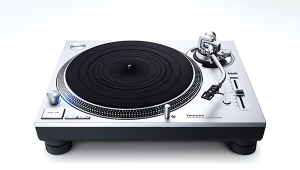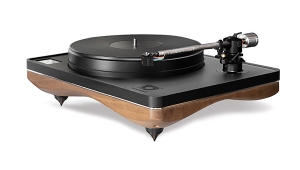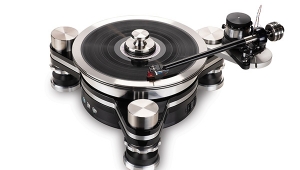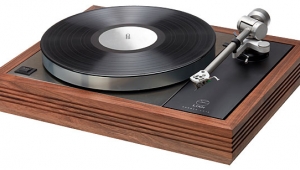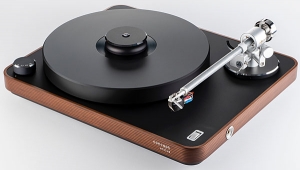| Columns Retired Columns & Blogs |
SOTA Star Sapphire turntable
The SOTA Sapphire was the first, and the most successful in terms of sales, of the new generation of high-end American turntables. As such, the SOTA can be viewed as leading this country's resurge ence of interest in high-quality turntable production. At the time of the SOTA's introduction in 1981, it was the only high-end turntable manufactured in the US. Since then American-made turntables have appeared from the likes of AR, Mapleknoll, Sonographe, and VPI.
Footnote 1: The author purchased the unit used for this review before beginning evaluation of the product. Thus, the possible effect of personal bias (the tendency to reach a conclusion which supports the decision to purchase) must be considered by the reader. However, it should also be noted that the reviewer did have an opportunity to use a Star for four days before committing to purchase.—Steven W. Watkinson
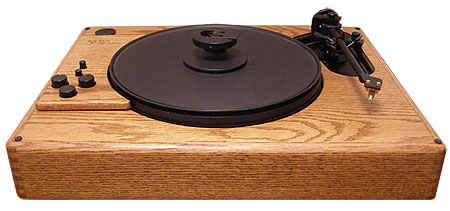
In retrospect, the reasons for the SOTA's success seem obvious. The turntable is visually and constructionally ime pressive and instills in the buyer confidence that he is receiving value for money. It is easy to set up properly, even by one not technically inclined or blessed with secret knowledge, and once set-up right it stays that way. Isolation is excellent; even a firm rap of the knuckles on the plinth while a record is playing does not produce an adverse effect. Finally, and most importantly, the SOTA offers first-class sound quality.
Riding on the crest of its success, SOTA has introduced a new, up-market version of its turntable. Labeled the Star Sapphire (footnote 1), the new model is identical to the standard SOTA except for more costly cosmetics and the inclusion of a vacuum record-clamping system. The cosmetic changes cOnsist of a wood-veneered top panel (matching the plinth) and a more substantial dust cover. The vacuum system and cosmetic changes do not come cheap: the Star's price tag is $550 higher than the standard SOTA (footnote 2).
Star Quality
Setup of the Star is identical to that of the standard SOTA except for slipping on a vacuum tube and setting the vacuum-level control. Setup took about 40 minutes, most of it spent freeing the turntable from its packaging materials.
Since the arm and cartridge were previously mounted on a standard SOTA, I only had to move the old armboard to the new turntable. SOTA's manufacturing tolerances are quite impressive—the old board fit the new 'table as if they had been hand matched. A quick check with plumb line and protractor indicated that the angle of the armtube relative to the surface of the platter had changed by less than a quarter of a degree, and listening established that the VTA/SRA setting had remained right on the money. There was only one flaw noted in the review unit. The control panel cover, as it came from the factory, was too wide. A short session with some sandpaper corrected the problem, but one has the right to expect more from a turntable of this price.
Operation of the vacuum feature proved hassle-free. The molded elastomer platter mat has an upturned outer lip which forms a seal against the thickened rim of the record. After the vacuum control knob is set at the desired level, a rubber plug is slipped over the spindle to make an air seal around the hole in the record.
When the turntable is switched on, the vacuum pump starts up and air under the record is evacuated through two small holes in the platter. A high vacuum is created for the first four seconds and supplemented by continuous evacuation at lower suction while the record plays. The pump's rather prominent hum (similar to a severe ground loop) during the startup period prompted anxiety the first time around. After the vacuum is reduced, pump noise drops to an unobtrusive level. Pump noise might prove a problem in a small room when listening at low levels; I was able to place the pump (which is housed separately) far enough away so it was totally inaudible.
A major criticism leveled against vacuum record-clamping systems is that they damage records by extracting the plasticizers from the side ofthe record exposed to the vacuum (see Vol.6 No.6, pp.16–17). Plasticizers are used in records to keep the vinyl compliant, and if a sufficient loss of plasticizers occurs, the vinyl will become hard and brittle. When an LP is played in such condition, the stylus knocks chunks of vinyl from the wall of the groove, and the result is a very noisy, permanently damaged record.
SOTA claims, based on "hard and extensive research," that the Star avoids this problem by employing a very low vacuum. Their research indicates that a vacuum of 7–8" of mercury (or higher with premium vinyl) is needed before plasticizer migration occurs. Since the Star applies continuous suction (rather than a one-time initial suction), 4–5" of mercury is applied when turned on, but this drops to 1–3" while playing (footnote 3).
I can confirm SOTA's claim of no record damage. After using the Star for three months, I have noticed no damage to my records. In fact, I lent several records to a manufacturer who played them numerous times on the Star at last summer's CES. Ten months later, I detect no deterioration (other than normal record wear) in these records.
I was somewhat skeptical that such a low level of vacuum would be sufficient to clamp a record properly, but use of the Star has me convinced. For those who must see to believe, the upturned outer edge of the platter mat is compressed when an adequate vacuum level is achieved, allowing visual confirmation that all is working well. After playing several hundred records at an altitude of approximately 1300' above sea level, I never once failed to obtain or maintain a vacuum, even with the vacuum control knob only a third of the way up.
Sound Quality
A Sumiko MDC-800 tonearm and Talisman S cartridge were used for evaluating the Star. The rest of the system included the Dayton Wright MG-l0 Mk.2 speakers, the BEL 2002 amplifier, and the Dayton Wright head-amp and preamp. For this review the Star was compared with the standard SOTA turntable. Since the standard SOTA has not been reviewed in Stereophile, a few words are in order. I acquired one in the fall of 1982. The superiority of the SOTA over the Linn and Thorens 'tables I had previously used was apparent after only a short listening session. The SOTA had a cleaner, more detailed midrange, tighter and more extended bass, and far less harshness or glassiness in the high frequencies. Most important, the SOTA had significantly less coloration than the other 'tables. Particularly noticeable was the absence of the upper bass/lower midrange hump which plagues the Linn. The only immediately apparent anomaly was a mild hardness in the upper midrange which occasionally made the music sound overexcited. This problem was eliminated by a change to the new SOTA mat which was introduced last summer.
The SOTA was also a more convenient and practical turntable. Lack of isolation from vibration was a constant problem with the Thorens and an occasional problem with the Linn. Placement is critical with both 'tables; sound quality could vary significantly depending upon location and sturdiness of support. The SOTA was virtually unaffected by placement. It could be located anywhere in the listening room and on any piece of furniture strong enough to support its 50 lb weight. The additional advantages of automatic speed selection and adjustable pitch soon became appreciated conveniences. Even better, the SOTA required no further adjustment once it was set up.
The Star Sapphire retains the convenience and practicality of the standard SOTA, while adding the feature of vacuum holddown. Is it better than the standard SOTA, and if so, by how much? In a word, the Star doesn't do anything enormously better than the standard model, except when playing severely warped records. Rather, the Star seems to do everything somewhat better. Overall, the sound is more relaxed and natural. Music is presented in an effortless manner and the entire system conveys the impression of less strain. This doesn't mean the sound is laidback: when tension is present in the music, the presentation has an awesome impact that leaves one clinging to the edge of one's seat.
Turning to specifics, bass extension and weight are not noticeably improved, but the bass is tighter. Good bass lines on jazz or popular recordings are easier to follow and string bass notes are more readily distinguished from drum beats. on classical music, the double-bass section becomes precisely located and the bass lines more distinct. The natural explosiveness of a bass drum struck hard is well conveyed, and the sweet, slow buzz of the tuba is captured properly.
It's in the upper midrange and high frequencies, however, where the Star most exceeds the performance of the standard SOTA. The mild hardness of the standard model was reduced substantially. The upper frequencies seem to open up, presenting a more natural ambience and allowing the subtleties of delicate passages to be more easily discerned. High-frequency tones from synthesizers and percussion have greater purfry, and differences between similar-sounding instruments, such as hi-hat and crash-and-ride cymbals, are more apparent. However, mistracking on highs frequency passages, if present, also became more noticeable. Precise cartridge alignment is critical if the Star's advantages at high frequencies are to be preserved.
This purity is preserved throughout the frequency spectrum, and particularly noticeable on pianos and brass. Up till now, I've harbored a malevolent desire to strangle all recording engineers for what they've done to the sound of pianos; now I think that at least some have managed to get it right.
This clarity and increased definition in the midrange can be startling. Problems in recording technique, such as microphone switching, overloading, and cross-field effects, become more obvious. Extraneous noises, particularly those made by musicians, are clearer and readily identifiable as to cause. Recording problems in the bass range become more obvious as well. It is easier to distinguish cutting-lathe rumble (evident on some older American records) from the traffic and foundation vibration noise common on British recordings of chamber groups. The effects of eigenmode reinforcement and infrasonic resultants on organ recordings not employing a high-pass filter are more pronounced.
Perhaps because of the increased definition, an improvement was noted on transients and intertransient silence. Particularly with electrostatic speakers, the Star sounded faster; notes started and stopped with more lifelike precision. The subtle details present at the start of an instrumental attack are captured with remarkable accuracy.
While not effecting any obvious improvement in soundstage width or depth, the Star did achieve a more precise, tighter center focus, with less horizontal smear. The first impression was of reduced soundstage width, but width actually was unchanged; in fact, the standard SOTA sounded slightly loose in comparison with the Star. While soundstage depth did not increase, the apparent depth presented by the Star was more convinc ing. It simply did a better job of persuad ing me that I was hearing music from a three-dimensional space.
Surprisingly, significant changes in the sound can be made by varying vacuum level. On most records, the best setting of the vacuum control knob seemed to be a quarter to a third of the way up. At this level, all the benefits of the vacuum feature were obtained. Increasing the vacuum level above this optimal setting caused a dulling of the overall sound and a noticeable loss of dynamics (not to mention the increased possibility of leached plasticizer).
Even with the vacuum set at the optimal level, I experienced some apparent loss of dynamics compared with the standard SOTA. Conversations with representatives of SOTA confirmed that they also had noticed a loss of dynamics on the Star, but only when the vacuum level was set too high. They suspect the problem may be attributable either to overdamping or to inherent variations in the thickness of records, but they concede they really aren't sure. Left unexplained to me is the slight loss of dynamics I experienced when the vacuum was set optimally.
One possibility is that the apparently greater dynamics with the standard SOTA is in fact only an increase in transient-induced harmonic distortion, as when an electric guitar is played through a fuzzbox. The greater harmonic distortion caused by the fuzzbox makes the guitar sound louder, even though there is no increase in the measurable sound pressure level. Turning off the fuzzbox results in a perceived loss of dynamics.
I found a way of restoring the lost dynamic level, but with some cost in detail and perhaps record wear: increasing the tracking force of the tonearm. The sacrifice of detail indicates to me an increase in distortion; even so, the level of detail and definition remains better than the standard SOTA, and perceived dynamics become as good. While the theoretical question remains disturbingly unanswered, it is possible for the user to restore the lost dynamics (which are perhaps false).
Finally, it seems necessary to say something about the advantages of the Star on warped records. Since my collection is not well endowed with severely warped records, I went out and borrowed some. Severely warped records do sound better on the Star; even so, they couldn't be made to sound asgood as flat ones. I find SOTA's emphasis on the Star's advantages with warped records to be misplaced and unfortunate. The Star should not be purchased with the belief that it will produce great sound from warped records. Most badly warped records seem to have other flaws as well, which simply become all the more apparent when played on the Star. The Star is at its best with good records. It makes them sound marvelous. The absolute amount of improvement obtained may not be as great as the improvement with badly warped records, but the end result is far more rewarding.
Overall Quality
We come now to the final evaluation: Is the Star worth its extra cost? On the basis of sound quality alone, I have no doubt that the Star is well worth its asking price when used in a state-of-the-art system. The improvements over the sound of the standard SOTA are subtle, but they become more and more obvious with extended listening. It is clearly better-sounding than any of the British 'tables I have heard. The Star is a reference-quality turntable; I consider it state-of-the-art, In view of the cost of other premium turntables, the Star's price certainly seems reasonable and must be considered as offering excellent value for the money (footnote 4).—Steven W. Watkinson
Footnote 1: The author purchased the unit used for this review before beginning evaluation of the product. Thus, the possible effect of personal bias (the tendency to reach a conclusion which supports the decision to purchase) must be considered by the reader. However, it should also be noted that the reviewer did have an opportunity to use a Star for four days before committing to purchase.—Steven W. Watkinson
Footnote 2: The Star is an addition to the SOTA line, and not a replacement for the standard model. A factory vacuum-conversion kit for existing SOTAS is supposed to be made available for approximately $400.—Steven W. Watkinson
Footnote 3: We at Stereophile applaud the move to a low-vacuum system, considering the problems we had with Technics' vacuum disc stabilizer (Vol.6 No.6). We must point out, however, that we have seen neither SOTA's research nor independent confirmation of SWW's experience.—Larry Archibald
Footnote 4: The above review was written based on the initial price of the SOTA Star, which was $1250 (the current price of $1400 is reflected in the specifications at the head of the article). The price increase of approximately 15% does not alter my conclusion that the Star offers excellent value for money. What the price increse does do is make the standard SOTA with a factory-installed vacuum system an even better value. I leave it up to the individual reader whether the cosmetics of the Star are worth the extra $150.—Steven W. Watkinson
- Log in or register to post comments
